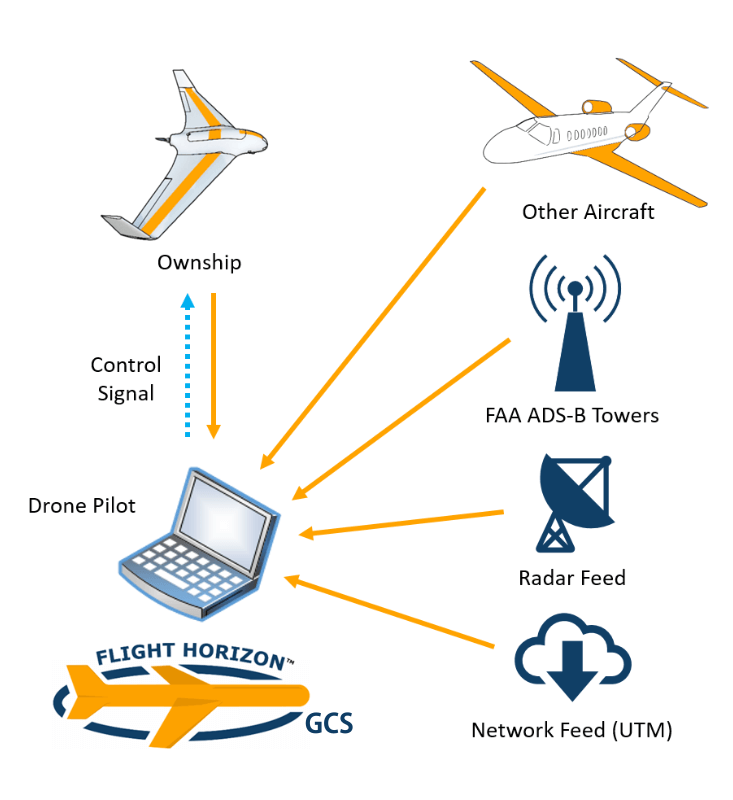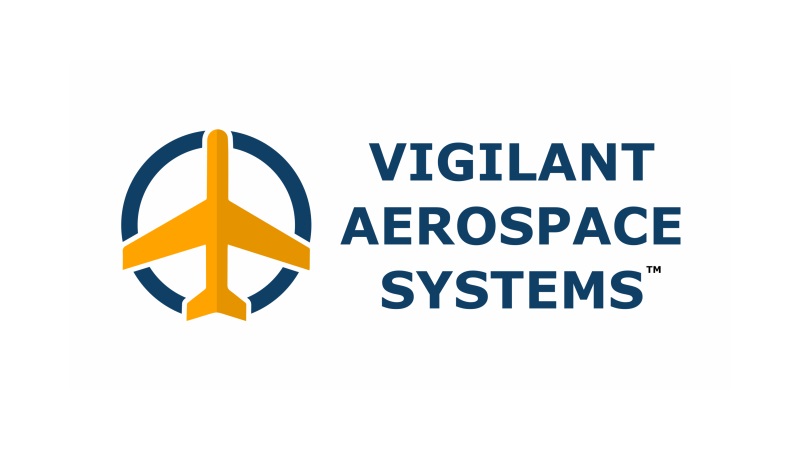Vigilant Aerospace has registered as an Interested Party in the FAA’s new UAS Integration Pilot Program (UIPP), which is designed to allow state, local and tribal governments in the US to create Innovation Zones in which advanced UAS operations can be carried out and data collected. As a registered Interested Party, Vigilant Aerospace can provide its complete detect and avoid (DAA) and airspace traffic management (ATM) system, called
FlightHorizon, to Lead Applicants in the program.
To learn more about
FlightHorizon, be sure to visit our
Products and Services Overview page. You can find details on what the FAA’s UIPP is here: UAS Integration Pilot Program
FlightHorizon can help Lead Applicants to fulfill the FAA’s request for technologies to demonstrate advanced UAS operations related to beyond visual line-of-sight operations, night operations, aircraft tracking, aircraft navigation and weather information and awareness.
Vigilant Aerospace Interested Party Overview
Capabilities

FlightHorizon software from Vigilant Aerospace Systems, Inc. provides both individual UAS pilots and airspace managers with a complete situational awareness and detect-and-avoid system, integrating data from aviation transponders, airborne and ground-based radar, and other sources to provide airspace visualization, air traffic alerts, warnings and avoidance commands.
The system can be configured for either piloted or autonomous unmanned aircraft and can be used on board the aircraft, at a ground control station or in a command center. The system uses off-the-shelf hardware, integrates with existing FAA air traffic control via ADS-B and can be used simultaneously by individual pilots and airspace managers to provide both detect-and-avoid and overall airspace visibility.
Based on unique, patented technology licensed from NASA by Vigilant Aerospace, the system checks for potential conflicts multiple times per second and can provide visual, textual and audible guidance for self-separation, maintenance of well-clear and safe flight operations. In addition, the system provides detailed airspace and flight logging, including both a proprietary, high-performance airspace logging format and a full binary signals log, both of which can be replayed in FlightHorizon for detailed flight and mission analysis.
Past Performance
The latest version of FlightHorizon has been and is currently utilized in critical flight operations by NASA for airspace monitoring and management, manned and unmanned aircraft deconfliction and detailed airspace logging. Missions have included the NASA SonicBAT supersonic aircraft development program at NASA Armstrong Flight Research Center and the ND/MAX program at the NASA Aeronautics Research Mission Directorate.
Prior to those operations, beyond visual line-of-sight flight testing of FlightHorizon was conducted at NASA Armstrong Flight Research Center in December 2016 and July 2017 with 350 live flight encounters and avoidance maneuvers. Flight tests of the system have been documented in papers published by The American Institute of Aeronautics and Astronautics, co-authored by NASA and Vigilant Aerospace Systems, including “Application of an ADS-B Sense and Avoid Algorithm” (AIAA Applied Aerodynamics Conference; 34th; 13-16 Jun. 2016; Washington, DC; United States) and upcoming paper, “Automatic Dependent Surveillance Broadcast: μADS-B Detect-and-Avoid Flight Tests” (AIAA SciTech Forum 2018; 8–12 Jan. 2018, Kissimmee, FL.)
Download the Interested Party Overview here:
Vigilant Aerospace Systems – UAS Integration Pilot Program Interested Party Overview [PDF]
How is Vigilant Aerospace involved?
Vigilant Aerospace will be providing our FlightHorizon system to local governments developing Innovation Zones. Vigilant Aerospace has
registered with the program as an Interested Party, which are product vendors who are prepared to support
Lead Applicants.
If you are applying to create one of the new Innovation Zones,
be sure to contact us for a comprehensive detect-and-avoid and airspace management solution.
Read more about the UAS Integration Pilot Program in our blog post:
“Exploring the FAA’s New UAS Integration Pilot Program”
FlightHorizon – Benefits to UAS Integration Pilot Program Application
FlightHorizon provides both individual UAS pilots and airspace managers with situational awareness, air traffic alerts, collision warnings and specific avoidance and self-separation commands with visual and audible guidance to help make correct, split-second decisions.
Advanced Detect-and-Avoid Technology
The system uses off-the-shelf hardware, integrates with existing FAA air traffic control via ADS-B and can be used simultaneously by individual pilots and airspace managers to provide both detect-and-avoid and overall airspace visibility. FlightHorizon integrates data from aviation transponders (ADS-B, ADS-R and TIS-B), airborne and ground-based radar, and other sources to provide airspace visualization, air traffic alerts, warnings, and avoidance commands.
Based on unique,
patented technology licensed from NASA by Vigilant Aerospace, the system checks for potential conflicts multiple times per second and can provide visual, textual and audible guidance for self-separation, maintenance of well-clear and safe flight operations.
Safety and Awareness for Beyond Visual Line-of-Sight Operations
FlightHorizon can be configured for either piloted and autonomous unmanned aircraft and can be used on board the aircraft, at a ground control station or in a command center.
For autonomous aircraft, FlightHorizon delivers full conflict detection, makes a self-separation decision and sends a specific command to the autopilot to avoid collisions.
For airspace managers, FlightHorizon provides airspace visibility, visualization in two or three dimensions, specific aircraft tracking, conflict detection, self-separation commands and resolution monitoring.
Airspace & Flight Logging
In addition, the system provides detailed airspace and flight logging, including both a proprietary, high-performance airspace logging format and a full binary signals log, both of which can be replayed in FlightHorizon for detailed flight and mission analysis.
To start a conversation, contact us with your questions and comments, here: www.VigilantAerospace.com/contact  FlightHorizon software from Vigilant Aerospace Systems, Inc. provides both individual UAS pilots and airspace managers with a complete situational awareness and detect-and-avoid system, integrating data from aviation transponders, airborne and ground-based radar, and other sources to provide airspace visualization, air traffic alerts, warnings and avoidance commands.
The system can be configured for either piloted or autonomous unmanned aircraft and can be used on board the aircraft, at a ground control station or in a command center. The system uses off-the-shelf hardware, integrates with existing FAA air traffic control via ADS-B and can be used simultaneously by individual pilots and airspace managers to provide both detect-and-avoid and overall airspace visibility.
Based on unique, patented technology licensed from NASA by Vigilant Aerospace, the system checks for potential conflicts multiple times per second and can provide visual, textual and audible guidance for self-separation, maintenance of well-clear and safe flight operations. In addition, the system provides detailed airspace and flight logging, including both a proprietary, high-performance airspace logging format and a full binary signals log, both of which can be replayed in FlightHorizon for detailed flight and mission analysis.
FlightHorizon software from Vigilant Aerospace Systems, Inc. provides both individual UAS pilots and airspace managers with a complete situational awareness and detect-and-avoid system, integrating data from aviation transponders, airborne and ground-based radar, and other sources to provide airspace visualization, air traffic alerts, warnings and avoidance commands.
The system can be configured for either piloted or autonomous unmanned aircraft and can be used on board the aircraft, at a ground control station or in a command center. The system uses off-the-shelf hardware, integrates with existing FAA air traffic control via ADS-B and can be used simultaneously by individual pilots and airspace managers to provide both detect-and-avoid and overall airspace visibility.
Based on unique, patented technology licensed from NASA by Vigilant Aerospace, the system checks for potential conflicts multiple times per second and can provide visual, textual and audible guidance for self-separation, maintenance of well-clear and safe flight operations. In addition, the system provides detailed airspace and flight logging, including both a proprietary, high-performance airspace logging format and a full binary signals log, both of which can be replayed in FlightHorizon for detailed flight and mission analysis.

